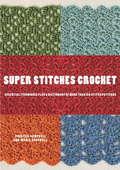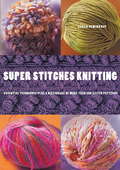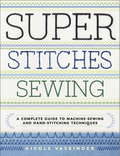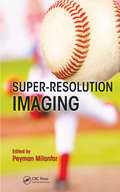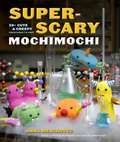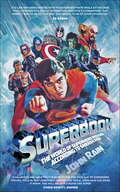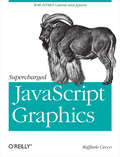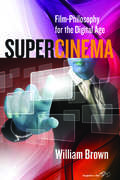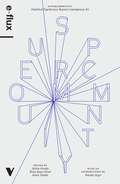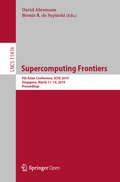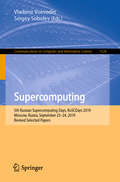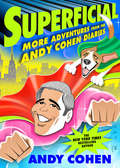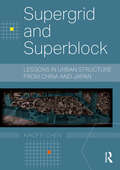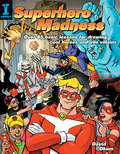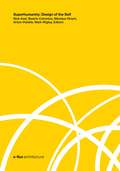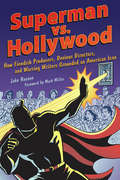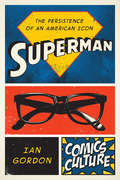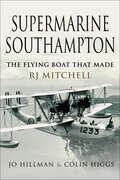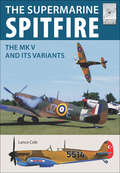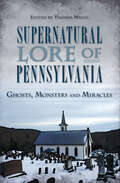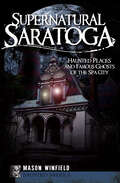- Table View
- List View
Super Stitches Crochet
by Ann-Marie Bakewell Jennifer CampbellHandy reference for all crochetersDo you really think a broken mirror means seven years of bad luck? Come on. Superstitions are useless. Now, Super Stitches Crochet--that's useful! Super Stitches Crochet offers a complete introduction to this favorite craft, plus an illustrated dictionary of more than 180 stitches and patterns. Solids, openwork, fans, trellises, arches, laces, textures, medallions, shapes, edgings, and more are shown with instructions and diagrams on left-hand pages and a photo of a crocheted sample swatch on the opposite page. This follow-up to the super-successful Super Stitches Knitting includes information on choosing yarns, selecting hooks, understanding symbols and abbreviations used in crocheting patterns, essential crochet techniques, and the stitches and formations that are the essentials of all crochet work. Look, throwing salt over your shoulder won't keep you busy forever. You need Super Stitches Crochet!* User-friendly lay-flat binding* Unbeatable illustrated reference* Great for crocheters at every level
Super Stitches Knitting
by Karen HemingwayA complete guide to more than 300 knitting stitches, shown in diagrams and photos"Very super stitches...nothing more to say!" Stevie Wonder said it all for us. Although we do have afew more words we'd like to get in here. Don't be superstitious, because you can believe in SuperStitches Knitting, the complete pocket guide to knitting stitches and a great how-to-knit guide.Author Karen Hemingway presents full how-tos for all the essentials of knitting, including choosingneedles and yarn, casting on, binding off, increasing and decreasing, creating texture, working withmultiple colors, fixing mistakes, and finishing. Then Super Stitches Knitting turns to the stitch patterns--more than 300 of them, all fully explained in how-tos and full-color photos. Instructions and diagrams for each stitch, including knit and purl, vertical motifs, ribbing, borders, dimensional elements, cables, eyelet, lace, color knitting, and more, are shown on lefthand pages, and a photograph of the knitted result is on the right-hand page. This essential book, packed with super stitches, makes knocking on wood, throwing salt, and avoiding black cats completely unnecessary for knitters at every level from beginning to advanced.
Super Stitches Sewing
by Nicole VasbinderThe Perfect Stitch for Every Project Does your sewing machine come with lots of fancy stitches that you've never thought to try? This essential guide to machine and hand stitches will teach you how to use any and every stitch for professional-looking seams, hems, gathers, darts, and more. Unlock your full sewing potential with 57 machine stitches, 18 hand stitches, and tips to choose the correct needles, threads, and sewing machine accessories, complete with detailed step-by-step tutorials and illustrations. This comprehensive stitch dictionary is a must-have companion for any sewer, whether you just bought your first sewing machine or you're a seasoned expert looking to polish your skills. If your passion is dressmaking, tailoring, or simply mending your own clothes, Super Stitches Sewing gives you all of the information you need to make every project a success.
Super-Resolution Imaging (Digital Imaging and Computer Vision)
by Peyman MilanfarWith the exponential increase in computing power and broad proliferation of digital cameras, super-resolution imaging is poised to become the next "killer app." The growing interest in this technology has manifested itself in an explosion of literature on the subject. Super-Resolution Imaging consolidates key recent research contributions from eminent scholars and practitioners in this area and serves as a starting point for exploration into the state of the art in the field. It describes the latest in both theoretical and practical aspects of direct relevance to academia and industry, providing a base of understanding for future progress. Features downloadable tools to supplement material found in the book Recent advances in camera sensor technology have led to an increasingly larger number of pixels being crammed into ever-smaller spaces. This has resulted in an overall decline in the visual quality of recorded content, necessitating improvement of images through the use of post-processing. Providing a snapshot of the cutting edge in super-resolution imaging, this book focuses on methods and techniques to improve images and video beyond the capabilities of the sensors that acquired them. It covers: History and future directions of super-resolution imaging Locally adaptive processing methods versus globally optimal methods Modern techniques for motion estimation How to integrate robustness Bayesian statistical approaches Learning-based methods Applications in remote sensing and medicine Practical implementations and commercial products based on super-resolution The book concludes by concentrating on multidisciplinary applications of super-resolution for a variety of fields. It covers a wide range of super-resolution imaging implementation techniques, including variational, feature-based, multi-channel, learning-based, locally adaptive, and nonparametric methods. This versatile book can be used as the basis for short courses for engineers and scientists, or as part of graduate-level courses in image processing.
Super-Scary Mochimochi: 20+ Cute and Creepy Creatures to Knit
by Anna Kathleen HrachovecToys to Scare You Silly!What creatures lurk in the darkest shadows of Mochimochi Land? Only the most adorable assortment of knitted monsters, such as tiny vampire brats, a teenage werewolf, and a miniature gang of killer bees. They may be more cute than scary, but try not to bruise their egos. These toys think they're terrifying! You'll find 20 patterns for big beasties, tiny critters, and even goblins that will gobble up your iPad, all rendered in Anna Hrachovec's quirky signature style. Or create your own mix ʼn' match monster with more than 20 customizable body parts and features that you can assemble any way you want. After all, nothing is scarier than a clever knitter armed with yarn, needles, and a wild imagination.Whether you're already a devoted fan of mochimochi, love scary stuff, or just need a good laugh, Super-Scary Mochimochi offers everything you need to knit your own world of creatures that will go bump in the night in the cutest way possible.
Superando el Cáncer de Colon
by David Arieta Galván Tim DarvellEn abril del 2012 la temida palabra cáncer llegó a nuestra familia. Estuve sentado un minuto con mi madre esperando una alta normal del hospital, y luego en un parpadeo nuestro mundo estaba de cabeza cuando nos dijeron que mamá tenía cáncer de colon. Este libro contará con fotos sobre diversos temas, ideas y aspectos técnicos. Este es un libro de caridad con una colección de fotografías y las historias detrás de ellas para recaudar fondos para la organización "Superando el Cáncer de Colon", Todo lo recaudado se donará a la caridad.
Superbook: The World of Superhero Movies According to Smersh Pod
by John RainIf you mention the word ‘superhero’ these days, everyone and their mum can tell you a potted history of it all, because they’ve sat through numerous phases, extended TV series, and animated side-specials of expansive character-development, culminating in extraordinary final chapters, with the screen literally stacked full of characters battling one another while your eyes bleed with excitement and spectacle. But before 1997, people would generally only think of a few things: Christopher Reeve smiling as he keeps a watchful eye over Earth’s atmosphere, Michael Keaton running around Gotham while dressed in molded rubber. Nicholas Hammond's Spider-Man being hauled up a wall on a rope, pretending to grip it, while also being a foot away from it. Bill Bixby trying not to get angry, Flash Gordon arriving in another galaxy, that was essentially a soft porn film, Dolph Lundgren mumbling in broken English while Frank Langella hammed behind a mask, and how Michael Crawford dressed like a bird was the closest thing Disney had to a cinematic universe. Despite starting on a high in 1978, by 1997 there could be no doubt that the genre was dead. Out was the sheen of verisimilitude, and in were Bat-credit-cards, ugly CGI, slashed budgets, rubber nipples and Martin Sheen in a girdle. So, whatever happened to the heroes? Join John Rain as he walks through every film of note from 1978 to 1997, and examines just what went wrong, and how. Is it a bird? Is it a plane? No, it’s SUPERBOOK.
Supercharged JavaScript Graphics: with HTML5 canvas, jQuery, and More (O'reilly Ser.)
by Raffaele CeccoWith HTML5 and improved web browser support, JavaScript has become the tool of choice for creating high-performance web graphics. This faced-paced book shows you how to use JavaScript, jQuery, DHTML, and HTML5's Canvas element to create rich web applications for computers and mobile devices.By following real-world examples, experienced web developers learn fun and useful approaches to arcade games, DHTML effects, business dashboards, and other applications. This book serves complex subjects in easily digestible pieces, and each topic acts as a foundation for the next.Tackle JavaScript optimization and understand how it impacts performanceCreate fast-moving graphics by combining old-school DHTML with jQueryLearn advanced UI techniques using the jQuery UI and Ext JS librariesBuild games with collision detection, object handling, and JavaScript scrolling techniquesMaster HTML5 Canvas basics for drawings, fills, bitmaps, animation, and moreCreate applications for the small screen with jQuery Mobile and PhoneGapUse Google’s data visualization tools to create interactive dashboards
Supercinema
by William BrownDrawing on a variety of popular films, including Avatar, Enter the Void, Fight Club, The Matrix, Speed Racer, X-Men and War of the Worlds, Supercinema studies the ways in which digital special effects and editing techniques require a new theoretical framework in order to be properly understood. Here William Brown proposes that while analogue cinema often tried to hide the technological limitations of its creation through ingenious methods, digital cinema hides its technological omnipotence through the use of continued conventions more suited to analogue cinema, in a way that is analogous to that of Superman hiding his powers behind the persona of Clark Kent. Locating itself on the cusp of film theory, film-philosophy and cognitive approaches to cinema, Supercinema also looks at the relationship between the spectator and film that utilizes digital technology to maximum, 'supercinematic' effect.
Supercommunity: Diabolical Togetherness Beyond Contemporary Art
by E-Flux Julieta Aranda Brian Kuan Wood Anton VidokleLeading artists, theorists, and writers exhume the dystopian and utopian futures contained within the present“I am the supercommunity, and you are only starting to recognize me. I grew out of something that used to be humanity. Some have compared me to angry crowds in public squares; others compare me to wind and atmosphere, or to software.”Invited to exhibit at the 56th Venice Biennale, e-flux journal produced a single issue over a four-month span, publishing an article a day both online and on site from Venice.In essays, poems, short stories, and plays, artists and theorists trace the negative collective that is the subject of contemporary life, in which art, the internet, and globalization have shed their utopian guises but persist as naked power, in the face of apocalyptic ecological disaster and against the claims of the social commons.“I convert care to cruelty, and cruelty back to care. I convert political desires to economic flows and data, and then I convert them back again. I convert revolutions to revelations. I don’t want, I want to leave, and then disperse myself everywhere and all the time.”
Supercomputing Frontiers: 5th Asian Conference, SCFA 2019, Singapore, March 11–14, 2019, Proceedings (Lecture Notes in Computer Science #11416)
by Bronis R. de Supinski David AbramsonThis open access book constitutes the refereed proceedings of the 5th Asian Supercomputing Conference, SCFA 2019, held in Singapore in March 2019. The 6 full papers presented in this book were carefully reviewed and selected from 33 submissions. They cover a range of topics including memory fault handling, linear algebra, image processing, heterogeneous computing, resource usage prediction, and data caching.
Supercomputing Frontiers: 6th Asian Conference, SCFA 2020, Singapore, February 24–27, 2020, Proceedings (Lecture Notes in Computer Science #12082)
by Dhabaleswar K. PandaThis open access book constitutes the refereed proceedings of the 6th Asian Supercomputing Conference, SCFA 2020, which was planned to be held in February 2020, but unfortunately, the physical conference was cancelled due to the COVID-19 pandemic.The 8 full papers presented in this book were carefully reviewed and selected from 22 submissions. They cover a range of topics including file systems, memory hierarchy, HPC cloud platform, container image configuration workflow, large-scale applications, and scheduling.
Supercomputing: 5th Russian Supercomputing Days, RuSCDays 2019, Moscow, Russia, September 23–24, 2019, Revised Selected Papers (Communications in Computer and Information Science #1129)
by Vladimir Voevodin Sergey SobolevThis book constitutes the refereed post-conference proceedings of the 5th Russian Supercomputing Days, RuSCDays 2019, held in Moscow, Russia, in September 2019.The 60 revised full papers presented were carefully reviewed and selected from 127 submissions. The papers are organized in the following topical sections: parallel algorithms; supercomputer simulation; HPC, BigData, AI: architectures, technologies, tools; and distributed and cloud computing.
Supercool Paper Airplanes: 12 Paper Airplanes; Assembled in Under a Minute
by Andrew Dewar Kostya VintsThis supercool paper airplanes ebook contains the best planes you have ever seen!These 12 paper planes are easy to build- then the fun begins! Awesome paper planes include: The sci-fi inspired Thunder Bird is a technological marvel and an incredibly easy plane to assemble! The colorful Dragonfly has a unique 4-wing structure-highly unusual for a paper airplane! The high-tech SpaceShipTwo has a fuselage just like the real-life Virgin Galactic rocket ship. Unlike other origami airplanes, these are ready to go in under a minute, with no messy glue or tape required! A full-color instruction book provides clear information about each model and tips on how to fine-tune the planes to get better performance.Head right outdoors with this collection and have many hours of high-flying fun!
Supercute Animals and Pets: Christopher Hart's Draw Manga Now!
by Christopher HartFocusing on the charming and adorable pets and animals that enrich manga stories, Supercute Animals and Pets teaches readers how to draw animals from a fox, to a cow, to a penguin, all in the style of manga. After an introduction to basic body constructions, faces, tails, legs, and more, readers will have a chance to follow along Hart's in-depth step-by-steps, and will even be invited to draw on their own, right in the book's pages.
Superficial: More Adventures from the Andy Cohen Diaries
by Andy CohenThe megapopular host of Watch What Happens: Live and executive producer of The Real Housewives franchise is back, better than ever, and telling stories that will keep his publicist up at night. Since the publication of his last book, Andy has toured the country with his sidekick Anderson Cooper, hit the radio waves with his own Sirius station, Radio Andy, appeared on Real Time with Bill Maher despite his mother’s conviction he was not intellectually prepared, hosted NBC’s Primetime New Year’s Eve special, guest edited Entertainment Weekly, starred in Bravo’s Then & Now with Andy Cohen, offended celebrities with his ongoing case of foot-in-mouth disease, and welcomed home Teresa “Namaste” Giudice, from a brief stint in jail. Hopping from the Hamptons to the Manhattan dating world, the dog park to the red carpet, Cardinals superfan and mama’s boy Andy Cohen, with Wacha in tow, is the kind of star that fans are dying to be friends with. This book gives them that chance.
Supergrid and Superblock: Lessons in Urban Structure from China and Japan (Planning, History and Environment Series)
by Xiaofei ChenIn this superbly illustrated book Xiaofei Chen presents the first analysis in English of a ubiquitous East Asian urban phenomenon: the supergrid and superblock urban structure. The book opens with an introductory essay by Barrie Shelton in which he sets the scene for what is to follow, emphasizing how alien this structure was to Western urban design culture where radial patterns of development were the norm. Then, in her first chapter, Chen explains the make-up of the supergrid and superblock urban structure and its contrasting Chinese and Japanese forms. In the following three chapters she digs deep into the history, cultural origins, and underlying design philosophy of the supergrid and superblock to show how, under different cultural influences, the model has developed into two distinct forms. Two further chapters (5 and 6) provide detailed analysis of two sample superblocks in China (in Xi’an and Nanjing) and two in Japan (in Kyoto and Osaka) to reveal the relative advantages and disadvantages of how the structure is manifest in the two countries. In her conclusion she discusses her findings to show how and why the supergrid and superblock structure is a valuable urban design model which, with regional adjustments, can be used effectively in cities other than those of East Asia.
Superhero Madness
by David OkumTeaches basic superhero-style drawing with clear instruction and 100s of appealing illustrations. 40+ step-by-step demos.
Superhumanity: Design of the Self
by Nick Axel, Beatriz Colomina, Nikolaus Hirsch, Anton Vidokle, Mark WigleyA wide-ranging and challenging exploration of design and how it engages with the self The field of design has radically expanded. As a practice, design is no longer limited to the world of material objects but rather extends from carefully crafted individual styles and online identities to the surrounding galaxies of personal devices, new materials, interfaces, networks, systems, infrastructures, data, chemicals, organisms, and genetic codes. Superhumanity seeks to explore and challenge our understanding of &“design&” by engaging with and departing from the concept of the &“self.&” This volume brings together more than fifty essays by leading scientists, artists, architects, designers, philosophers, historians, archaeologists, and anthropologists, originally disseminated online via e-flux Architecture between September 2016 and February 2017 on the invitation of the Third Istanbul Design Biennial. Probing the idea that we are and always have been continuously reshaped by the artifacts we shape, this book asks: Who designed the lives we live today? What are the forms of life we inhabit, and what new forms are currently being designed? Where are the sites, and what are the techniques, to design others? This vital and far-reaching collection of essays and images seeks to explore and reflect on the ways in which both the concept and practice of design are operative well beyond tangible objects, expanding into the depths of self and forms of life. Contributors: Zeynep Çelik Alexander, Lucia Allais, Shumon Basar, Ruha Benjamin, Franco &“Bifo&” Berardi, Daniel Birnbaum, Ina Blom, Benjamin H. Bratton, Giuliana Bruno, Tony Chakar, Mark Cousins, Simon Denny, Keller Easterling, Hu Fang, Rubén Gallo, Liam Gillick, Boris Groys, Rupali Gupte, Andrew Herscher, Tom Holert, Brooke Holmes, Francesca Hughes, Andrés Jaque, Lydia Kallipoliti, Thomas Keenan, Sylvia Lavin, Yongwoo Lee, Lesley Lokko, MAP Office, Chus Martínez, Ingo Niermann, Ahmet Ögüt, Trevor Paglen, Spyros Papapetros, Raqs Media Collective, Juliane Rebentisch, Sophia Roosth, Felicity D. Scott, Jack Self, Prasad Shetty, Hito Steyerl, Kali Stull, Pelin Tan, Alexander Tarakhovsky, Paulo Tavares, Stephan Trüby, Etienne Turpin, Sven-Olov Wallenstein, Eyal Weizman, Mabel O. Wilson, Brian Kuan Wood, Liam Young, and Arseny Zhilyaev.
Superman vs. Hollywood: How Fiendish Producers, Devious Directors, and Warring Writers Grounded an American Icon
by Mark Millar Jake RossenTinseltown's fascination with the comic icon is detailed in this book, encompassing all the behind-the-scenes machinations that helped shape Superman into a screen legend--and all the derailed projects that have vilified everyone involved. These newly uncovered stories about the odyssey of bringing the Man of Steel to the big screen include the challenge of making Superman appear to fly, and the many casting processes, which at various points had Superman being played by the likes of Bruce Jenner, Robert Redford, Sylvester Stallone, Neil Diamond, Nicolas Cage, Justin Timberlake, Keanu Reeves, and even Muhammad Ali. Based on extensive interviews with producers, screenwriters, cast members, and crew, this exposé spills the beans on all the various TV shows, from the classic The Adventures of Superman to the current hit Smallville; the various animated efforts on both the large and small screens; and the movies--from 1979's smash hit Superman: The Movie to 2006's wildly expensive Superman Returns. Also included are the stories about the Superman movies that never made it to the screen, helmed by maverick directors Kevin Smith and Tim Burton, and featuring expenditures on scripts and sets that are even more eye-popping than the films' special effects.
Superman: The Persistence of an American Icon
by Ian GordonAfter debuting in 1938, Superman soon became an American icon. But why has he maintained his iconic status for nearly 80 years? And how can he still be an American icon when the country itself has undergone so much change?Superman: Persistence of an American Icon examines the many iterations of the character in comic books, comic strips, radio series, movie serials, feature films, television shows, animation, toys, and collectibles over the past eight decades. Demonstrating how Superman’s iconic popularity cannot be attributed to any single creator or text, comics expert Ian Gordon embarks on a deeper consideration of cultural mythmaking as a collective and dynamic process. He also outlines the often contentious relationships between the various parties who have contributed to the Superman mythos, including corporate executives, comics writers, artists, nostalgic commentators, and collectors. Armed with an encyclopedic knowledge of Superman’s appearances in comics and other media, Gordon also digs into comics archives to reveal the prominent role that fans have played in remembering, interpreting, and reimagining Superman’s iconography. Gordon considers how comics, film, and TV producers have taken advantage of fan engagement and nostalgia when selling Superman products. Investigating a character who is equally an icon of American culture, fan culture, and consumer culture, Superman thus offers a provocative analysis of mythmaking in the modern era.
Supermarine Southampton: The Flying Boat that Made R.J. Mitchell
by Colin Higgs Jo Hillman“Largely photographic coverage of the graceful 1920s flying boat designed by R.J. Mitchell of later Spitfire fame . . . A nostalgic look back.” —Helicopter InternationalThe Supermarine Southampton was the first flying boat to be designed for the RAF after the First World War. Produced between 1924 and 1934, it entered into RAF service in 1925 and became the second longest serving (behind the Short Sunderland) and one of the most successful of the inter-war flying boats.In an unusual move for the times, the Air Ministry ordered six Southamptons straight from the drawing board as the design had been based on the success of the experimental Supermarine Swan amphibious aircraft. So successful was the aircraft that a further twelve were ordered in July 1925.The Southampton was a hugely successful aircraft for the RAF, the aircraft’s main sponsor, and was used for reconnaissance duties and as a patrol aircraft. It became best known for a series of publicly lauded long-distance flights, the intention of which was partly “flag waving” and partly for gaining valuable experience of flying boats in remote waters. The 1927 Far East Flight became known for the Southampton’s display of its prodigious range and reliability.The Southampton was a very profitable series of flying boats with sales also being made to Argentina, Turkey and Japan almost doubling Supermarine’s business in just a few years. A total of eighty-three of all types were built, all of which are revealed in this unrivaled collection of archive images, the majority of which, having been drawn from private collections, have not been published before.
Supermarine Spitfire MKV: The Mark V and Its Variants
by Lance ColeThe story of the Supermarine Spitfire has been told across many years and the debate about it is enduring, yet the Spitfire remains a true icon. For aviation enthusiasts, for historians, for modellers, the word Spitfire conjures many stories and affections. This book presents the Spitfire enthusiast with an up-to-date history of the Spitfire not just in its design and application in war, but also as a flying memorial and as an aero modellers vital focus.The text examines recently revealed forgotten aspects of the Spitfire story; by combining the elements of design, the story of a weapon of war and a revered scale model, this book frames an essential chapter in aviation history. Packed with original and contemporary images and information, and displaying unique Spitfire model collections, the narrative bridges an important gap and is a worthy addition to the FlightCraft series.
Supernatural Lore of Pennsylvania: Ghosts, Monsters and Miracles (American Legends Ser.)
by Thomas WhiteLocal legends and paranormal mysteries of Pennsylvania—photos included. Strange creatures and tales of the supernatural thrive in Pennsylvania, from ghostly children who linger by their graves to werewolves that ambush nighttime travelers. Passed down over generations, Keystone State legends and lore provide both thrilling stories and dire warnings. Phantom trains chug down the now removed rails of the P&LE Railroad line on the Great Allegheny Passage. A wild ape boy is said to roam the Chester swamps, while the weeping Squonk wanders the hemlock-shrouded hills of central Pennsylvania, lamenting his hideousness. On dark nights, the ghosts of Betty Knox and her Union soldier beau still search for each other at Dunbar Creek. Join Thomas White and company as they go in search of the truth behind the legends of supernatural Pennsylvania.
Supernatural Saratoga: Haunted Places and Famous Ghosts of the Spa City (Haunted America)
by Mason WinfieldThe ghost walk tour leader and contributor to Haunted Rochester heads east for the horse races, famous springs, and a flood of paranormal phenomena. Author Mason Winfield, operator of Saratoga&’s Haunted History Ghost Walks, chronicles the Spa City&’s spookiest legends, from the Iroquoian zombie-like vampires to Benedict Arnold&’s Halloween apparitions. The heart of the city brims with lore, as covens work in secret in the Devil&’s Den neighborhood and phantoms linger at the Arcade on Broadway. In the shadow of the Adirondacks, spectral lights appear on remote Snake Hill, and the Woman in White haunts Saratoga Spa State Park. Explore the creepiest legends of Saratoga history, where some gamblers never leave and demons lurk in the forests. Includes photos!
